Walking through wave after wave of accents and animated conversations in foreign tongues this week among the 10,000 attendees at Autodesk University (#AU2016) in Las Vegas, I was reminded of history’s most famous construction project-turned-metaphor: the Tower of Babel.
That mythical Old Testament moonshot was famously doomed by the inability of designers, builders, engineers, and owners to communicate in ways each could understand. (Slave labor and safety woes likely would have posed problems, too.) Had today’s technology been available 3,000 years ago, though, perhaps universal translation tools would have enabled Babylonia’s hubris actually to touch the heavens. (Lord knows today’s Mesopotamia now seems hell-bent on getting there.)
_____________________________________________________________________
Multi-lingual conversations on the show floor and throughout the conference hallways flowed with collaborative hope and ambition
____________________________________________________________________
But in Las Vegas this week — despite fresh U.S. political concerns that hung like a very real cloud over otherwise festive proceedings — all was optimism for global architecture, engineering and construction. And the multi-lingual conversations on the show floor and throughout the conference hallways flowed with collaborative hope and ambition, a far cry from the Bible’s chaotic mash of acrimony and malice. Indeed, the energy, talent, and creativity that filled the #AU2016 exhibit halls and classrooms were cause for genuine optimism in an unusually strange historical moment.
Here, without further ado, are seven unscientific #AU2016 takeaways that hopefully convey that feeling:
1. Machine learning is real, and it’s ALREADY here
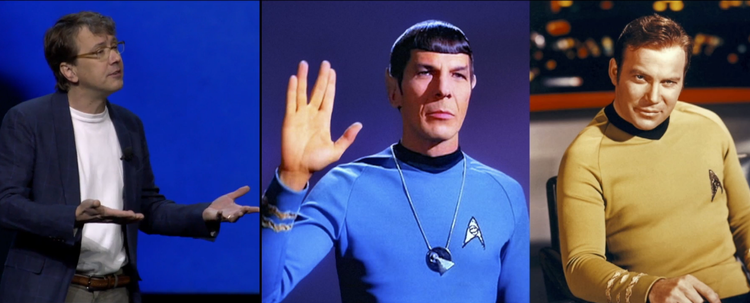
“Computers have always been a little bit like Mr. Spock. But today, they are becoming a lot more like Capt. Kirk
”
In his opening keynote, Autodesk CTO Jeff Kowalski showed the assembled masses how just this past summer, an Autodesk intern named Brittany, using the forthcoming prototype CAD system, Project Dreamcatcher, had instructed a computer to design the most comfortable and ergonomic chair for human work use. Employing Generative Design, “we don’t tell the computer what to do; we tell it what we need,” he explained. “We tell it what we want to accomplish, not what we already know.”
Marveling at the potential for “infinite expressibility,” Kowalski said Autodesk will make Dreamcatcher available commercially next spring.
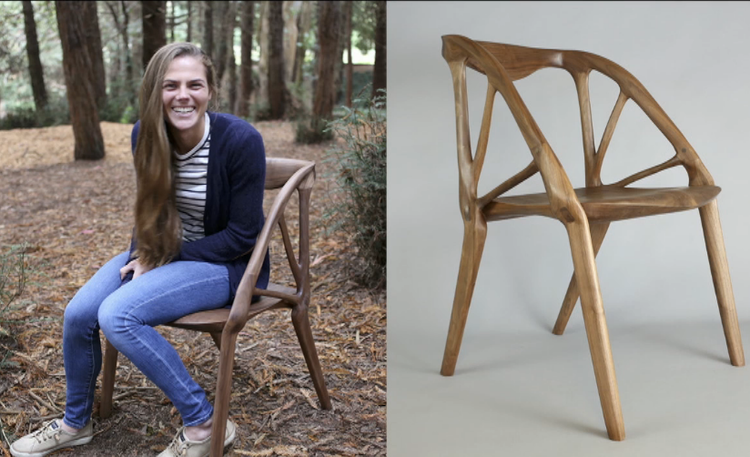
2. Return of the daqri smart helmet
It’s no secret. There’s been more than a little turmoil and turnover under the hood at Los Angeles-based DAQRI since the augmented reality (AR) product specialist unveiled its Smart Helmet in 2014. But now the improved prototype is backed by high-powered testimonials, presented on stage at #AU2016’s Day 2 Construction Launchpad. The event turned heads, as Mortenson Construction DVC Ricardo Khan and Autodesk BIM 360’s Stacy Scopano and Dace Campbell all teamed with DAQRI Chief Product Officer Roy Ashok to present a collaborative case study on the successful deployment of Smart Helmets on a recent expansion of the Hennepin County Medical Center outside Minneapolis MN. Here’s what attendees saw:
3. HP launches its new z2 MINI workstation
Technology pioneer HP continued to expand its AEC footprint, this time with the enthusiastic promotion of a new mini workstation for CAD. HP Global Product Management lead Josh Peterson said the new Z2 Mini “delivers breakthrough power and versatility in a small, elegant design,” combining capabilities perfected by 368,000 hours of testing and related feedback from AEC design professionals. “We’ve held nothing back,” said Peterson. “It’s packed with features including choice of full-performance Intel Core i7 or Xeon CPU’s, NVIDIA’s brand-new Quadro M620 professional graphics, and a Z Turbo Drive.”
Watch the video below to get a feel for the new product’s compact, potentially game-changing design.
4. Forge impresses with contractor integration
The technology lead for one large Midwestern general contractor commented to me that he had been particularly impressed this week with a presentation by Kansas City MO-based JE Dunn, an established firm that has made considerable commitment to technology. Over the last year, Dunn used Autodesk’s Forge APIs to build Lens — a custom-designed model-based estimating app that is cloud-based and always connected. It “harnesses and maximizes the value of information-rich models, combined with cutting-edge visualization technology to connect design data to elements of estimates.” Forge brings together advanced functionality and integrates with Dunn Dashboard and Autodesk BIM 360, “creating a seamless, transparent and connected ecosystem,” says the company. For more, see the video below.
5. expanding the power of doing good
In a town known for gaudy, gold-plated excess, it was both jarring and humbling to see two inspiring presentations from next-generation leaders in the opening keynote. The first came from 16-year-old Oregon high school junior Anna Nixon, already a national leader in promoting #STEMforGirls, and a major player in the FIRST Robotics Competition. Nixon actually brought her robot Prometheus with her on stage for a demo, having it shoot foul shots into the crowd with small basketballs. (Coincidentally, this reporter was hit in the face by one of those balls! But no harm, no foul.) Onstage, Dixon also rolled the dice by publicly challenging Autodesk CEO Carl Bass to allow students to help design future products.
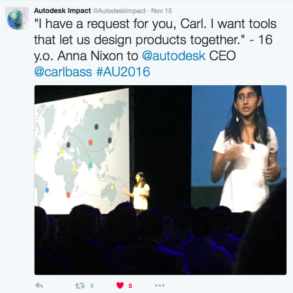
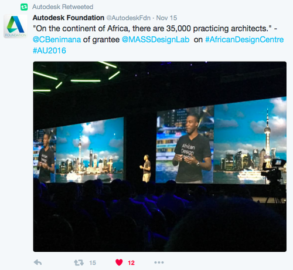
She was followed onstage by Christian Benimana, Rwanda’s first trained architect and programs director for MASS Design Group. Also representing the African Design Centre, he urged the crowd to look to Africa for future opportunity. Why? Because enormous need is looming larger each passing day. “By the year 2050, Africa’s population will have doubled to 2.5 billion people,” he said, underscoring the dire need for new infrastructure, schools, hospitals, etc., to handle the population explosion. “All of Africa today has only 35,000 professional architects,” he added. “Italy alone has 125,000.”
6. China dominates yet another awards program
Just two weeks after Chinese project teams had won more ‘Be Inspired’ awards than any other nation at Bentley Systems’ annual Year in Infrastructure conference in London, Chinese projects also dominated Autodesk’s AEC Excellence Awards. Leading the pack, BIAD (Beijing Institute of Architecture Design) claimed first place in the BUILDING category for The Phoenix International Media Center.
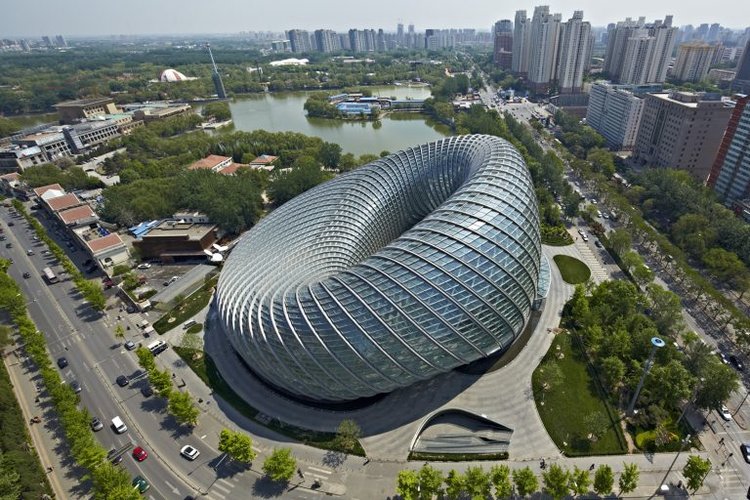
“Among one of the most visually breathtaking new buildings in Beijing – if not the world – it features a design inspired by the endlessly curving form of a Möbius strip, leaving visitors to wonder how the design team achieved such a striking form,” according to the awards citation. “The answer is that they turned to BIM to connect to insights that informed their design choices. The team decided to work exclusively with BIM tools and use paperless processes, making this project among the first in China to rely solely on BIM. BIM-based planning and conceptual design tools helped the team position the tallest elements of the building to minimize shading on nearby buildings while also improving energy efficiency.” For the rest of the awards, click here.
7. Carl Bass’s post-election letter
Released exclusively to BuiltWorlds, CEO Carl Bass allowed us to re-post publicly the extraordinary internal letter that he had sent to all 9,000-plus Autodesk employees on Nov. 10 to reassure them in the wake of the U.S. presidential election’s truly shocking result. Observing from Lisbon, he wrote, “It goes without saying that regardless of how we feel about the results of the election, starting immediately and especially at Autodesk University next week, we should treat each other, our partners and our customers with respect since we don’t all share the same views.” For the full letter, click here.
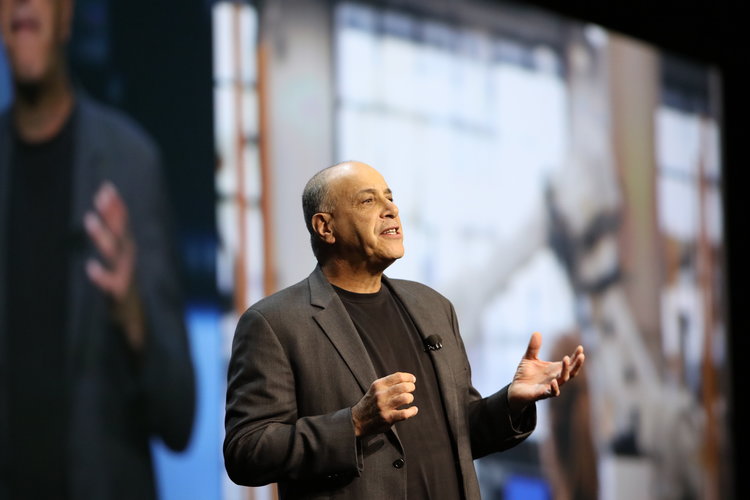

Discussion
Be the first to leave a comment.
You must be a member of the BuiltWorlds community to join the discussion.